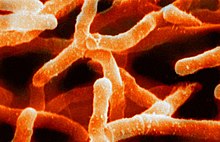테라박테리아
Terrabacteria| 테라박테리아 | |
|---|---|
 | |
| Actinomyces 이스라엘i(Actinomycetota) 주사전자현미경 | |
| 과학적 분류 | |
| 도메인: | 박테리아 |
| (순위 미지정): | 테라박테리아 Batistuzi et al., 2004, Batistuzi & Hedgings, 2009 |
| 필라 | |
| 동의어 | |
| |
테라박테리아는 그램 양성균류(방선균류와 바실로타)뿐만 아니라 시아노박테리아, 클로로플렉소타, 데이노코코타 [1][2]등 원핵생물종의 약 3분의 2를 포함하는 분류군이다.
그 이름은 육지에서의 생명의 진화적 압력에서 유래했다.테라박테리아는 환경적 위험(예: 건조, 자외선, 고염도)에 대한 저항성과 산소 광합성과 같은 중요한 적응을 가지고 있다.또한, 그램 양성 분류군의 세포벽의 독특한 특성은 많은 [2]종에서 병원성에 기여해왔다.이러한 결과는 현재 지구상의 적응이 현재 알려진 것보다 원핵생물 [1][2]진화에 더 큰 역할을 했을 가능성을 열어두고 있다.
테라박테리아는 방선균, 시아노박테리아, 데이노코코타[1] 등에 대해 2004년에 제안되었으며 이후 바실로타와 클로로플렉소타까지 [2]확장되었다.다른 계통발생학적 분석들은 이 식물들의 밀접한 관계를 뒷받침해 왔다.테라박테리아에 배치되지 않은 대부분의 원핵생물들은 공통된 조상에 대해 추론된 습한 환경을 참고하여 하이드로박테리아 [2]분류군에 배정되었다.일부 분자 계통학 분석에서는 테라박테리아와 하이드로박테리아라는 이분법이 뒷받침되지 않았지만,[4] 나무의 뿌리에 초점을 맞춘 것을 포함한 가장 [4][5]최근의 게놈 분석에서는 이 두 그룹이 단열체라는 [4]것이 밝혀졌습니다.
테라박테리아와 하이드로박테리아는 약 30억 년 전에 갈라져 육지(대륙)가 [2]원핵생물에 의해 식민지화되었음을 시사한다.테라박테리아와 하이드로박테리아는 함께 원핵생물 97%와 2009년까지 알려진 모든 세균의 99%를 포함하는 큰 그룹을 형성하고 그들의 광영양 능력(셀라스 = 빛)[8]을 암시하여 셀라박테리아 분류군에 배치된다.현재 테라박테리아+히드로박테리아 밖에 있어 셀라박테리아 분류를 정당화하는 세균의 필라가 논의되고 있으며, 후소박테리아를 [2][4]포함할 수도 있고 포함하지 않을 수도 있다.
"글리다박테리아"라는 이름은 테라박테리아에 일부 구성원을 포함했지만, 큰 그램의 양성 그룹인 바실로타와 방티노균세토타는 제외되었으며,[1][2][3][6][7][4][5] 분자 계통학 자료로는 뒷받침되지 않는다.게다가 글리도박테리아라고 명명된 논문은 분자 계통 발생이나 통계 분석을 포함하지 않았으며 널리 사용되는 3도메인 체계를 따르지 않았다.예를 들어, 그것은 화석 [10]기록과 모순되는 아주 최근에 진핵생물이 고세균에서 갈라졌고, 진핵생물과 고세균의 혈통이 방선균의 가까운 친척으로서 박테리아 안에 내포되었다고 주장했다.
계통발생학
Battistuzi and Hedges(2009)의 계통발생학적 분석에 따른 계통수는 다음과 같으며 분자 시계 [1][2]보정을 수반한다.
최근의 분자 분석에서는 관계가 [11][12][13][14][15][16]불확실했던 다른 식물군을 포함하여 대략 다음과 같은 관계가 발견되었습니다.
| 테라박테리아 |
| ||||||||||||||||||||||||||||||||||||||||||||||||||||||||||||||||||||||||||||||||||||||||||||||||||||||||||||||||||||||||||||||||||||||||||||||||
한편 Coleman 등은 Thermotogota, Deinococota, Synergiistota로 구성되고 관련성이 있는 분지군을 DST로 명명했으며, 분석 결과 초소형 박테리아(CPR 그룹)는 클로로플렉소타와 더 가까운 테라박테리아에 속할 수 있는 것으로 나타났다.이 연구에 따르면 물병균 문(Aquificota)은 때때로 하이드로박테리아에 속하며 후소박테리오타 문(Fusobacteriota)은 테라박테리아와 하이드로박테리아에 속할 수 있다.결과는 다음과 같습니다.[4]
| 테라박테리아 |
| ||||||||||||||||||||||||||||||||||||||||||||||||
레퍼런스
- ^ a b c d e Battistuzzi FU, Feijao A, Hedges SB (November 2004). "A genomic timescale of prokaryote evolution: insights into the origin of methanogenesis, phototrophy, and the colonization of land". BMC Evolutionary Biology. 4: 44. doi:10.1186/1471-2148-4-44. PMC 533871. PMID 15535883.
- ^ a b c d e f g h i Battistuzzi FU, Hedges SB (February 2009). "A major clade of prokaryotes with ancient adaptations to life on land". Molecular Biology and Evolution. 26 (2): 335–343. doi:10.1093/molbev/msn247. PMID 18988685.
- ^ a b Bern M, Goldberg D (May 2005). "Automatic selection of representative proteins for bacterial phylogeny". BMC Evolutionary Biology. 5 (1): 34. doi:10.1186/1471-2148-5-34. PMC 1175084. PMID 15927057.
- ^ a b c d e f g h Coleman GA, Davín AA, Mahendrarajah TA, Szánthó LL, Spang A, Hugenholtz P, et al. (May 2021). "A rooted phylogeny resolves early bacterial evolution". Science. 372 (6542): eabe0511. doi:10.1126/science.abe0511. PMID 33958449. S2CID 233872903.
- ^ a b c Léonard RR, Sauvage E, Lupo V, Perrin A, Sirjacobs D, Charlier P, et al. (February 2022). "Was the Last Bacterial Common Ancestor a Monoderm after All?". Genes. 13 (2): 376. doi:10.3390/genes13020376. PMC 8871954. PMID 35205421.
- ^ a b Hug LA, Baker BJ, Anantharaman K, Brown CT, Probst AJ, Castelle CJ, et al. (April 2016). "A new view of the tree of life". Nature Microbiology. 1 (5): 16048. doi:10.1038/nmicrobiol.2016.48. PMID 27572647. S2CID 3833474.
- ^ a b Zhu Q, Mai U, Pfeiffer W, Janssen S, Asnicar F, Sanders JG, et al. (December 2019). "Phylogenomics of 10,575 genomes reveals evolutionary proximity between domains Bacteria and Archaea". Nature Communications. 10 (1): 5477. Bibcode:2019NatCo..10.5477Z. doi:10.1038/s41467-019-13443-4. PMC 6889312. PMID 31792218.
- ^ Battistuzzi FU, Hedges SB (2009). "Eubacteria". In Hedges SB, Kumar S (eds.). The Timetree of Life. New York: Oxford University Press. pp. 106–115.
- ^ a b Cavalier-Smith T (July 2006). "Rooting the tree of life by transition analyses". Biology Direct. 1 (1): 19. doi:10.1186/1745-6150-1-19. PMC 1586193. PMID 16834776.
- ^ Knoll AH (2003). Life on a Young Planet : The First Three Billion Years of Evolution on Earth - Updated Edition. ISBN 0-691-00978-3. OCLC 1303471348.
- ^ Anantharaman K, Brown CT, Hug LA, Sharon I, Castelle CJ, Probst AJ, et al. (October 2016). "Thousands of microbial genomes shed light on interconnected biogeochemical processes in an aquifer system". Nature Communications. 7: 13219. Bibcode:2016NatCo...713219A. doi:10.1038/ncomms13219. PMC 5079060. PMID 27774985.
- ^ Matheus Carnevali PB, Schulz F, Castelle CJ, Kantor RS, Shih PM, Sharon I, et al. (January 2019). "Hydrogen-based metabolism as an ancestral trait in lineages sibling to the Cyanobacteria". Nature Communications. 10 (1): 463. Bibcode:2019NatCo..10..463M. doi:10.1038/s41467-018-08246-y. PMC 6349859. PMID 30692531.
- ^ Ji M, Greening C, Vanwonterghem I, Carere CR, Bay SK, Steen JA, et al. (December 2017). "Atmospheric trace gases support primary production in Antarctic desert surface soil". Nature. 552 (7685): 400–403. Bibcode:2017Natur.552..400J. doi:10.1038/nature25014. PMID 29211716. S2CID 4394421.
- ^ Tahon G, Tytgat B, Lebbe L, Carlier A, Willems A (July 2018). "Abditibacterium utsteinense sp. nov., the first cultivated member of candidate phylum FBP, isolated from ice-free Antarctic soil samples". Systematic and Applied Microbiology. 41 (4): 279–290. doi:10.1016/j.syapm.2018.01.009. PMID 29475572. S2CID 3515091.
- ^ Rinke C, Schwientek P, Sczyrba A, Ivanova NN, Anderson IJ, Cheng JF, et al. (July 2013). "Insights into the phylogeny and coding potential of microbial dark matter". Nature. 499 (7459): 431–437. Bibcode:2013Natur.499..431R. doi:10.1038/nature12352. PMID 23851394. S2CID 4394530.
- ^ Eloe-Fadrosh EA, Paez-Espino D, Jarett J, Dunfield PF, Hedlund BP, Dekas AE, et al. (January 2016). "Global metagenomic survey reveals a new bacterial candidate phylum in geothermal springs". Nature Communications. 7: 10476. Bibcode:2016NatCo...710476E. doi:10.1038/ncomms10476. PMC 4737851. PMID 26814032.



